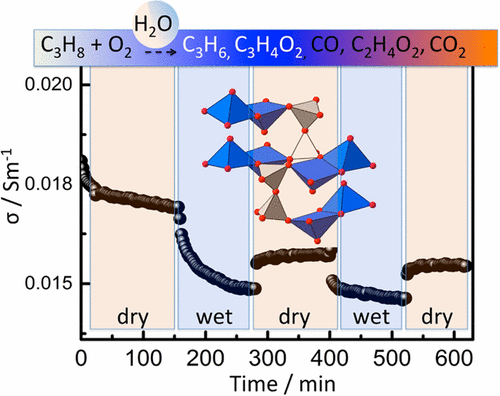当前位置:
X-MOL 学术
›
J. Phys. Chem. B
›
论文详情
Our official English website, www.x-mol.net, welcomes your
feedback! (Note: you will need to create a separate account there.)
Influence of Steam on a Vanadyl Pyrophosphate Catalyst During Propane Oxidation
The Journal of Physical Chemistry B ( IF 2.8 ) Pub Date : 2017-10-05 00:00:00 , DOI: 10.1021/acs.jpcb.7b06314 Maria Heenemann 1 , Christian Heine 1 , Michael Hävecker 2 , Annette Trunschke 1 , Robert Schlögl 1, 2
The Journal of Physical Chemistry B ( IF 2.8 ) Pub Date : 2017-10-05 00:00:00 , DOI: 10.1021/acs.jpcb.7b06314 Maria Heenemann 1 , Christian Heine 1 , Michael Hävecker 2 , Annette Trunschke 1 , Robert Schlögl 1, 2
Affiliation

|
We have investigated electronic and catalytic modifications of the p-type semiconducting selective oxidation catalyst vanadyl pyrophosphate (VPP) for propane oxidation in the presence and absence of steam. Steam changes propane conversion only slightly, but increases the selectivity toward oxygenates (acrylic acid, acetic acid) and the olefin propylene resulting in reduced selectivity of the undesired total oxidation products CO and CO2. Contact-free in operando microwave conductivity measurements at 0.1 MPa revealed that the modified catalytic performance is accompanied by a reduced electrical conductivity. Surface sensitive near-ambient-pressure X-ray photoelectron spectroscopy (NAP-XPS) and X-ray absorption spectroscopy (XAS) measurements at 25 Pa showed that steam depletes the topmost surface of VPP in phosphorus and enhances the average vanadium oxidation state slightly. These findings are accompanied by a decreased work function, but no detectable shift of the valence band edge is observed. Thus, the chemical surface modification changes the surface dipole but leaves the barrier height of the surface induced space charge layer basically unaffected. Hence, we conclude that steam does not affect the electron hole concentration (majority charge carriers) and hence the oxygen vacancy concentration. Therefore, the reduced conductivity can be understood in terms of charge carrier mobility changes, which may affect the selectivity of VPP toward oxygenates with steam. In addition, the modification of local properties, such as the concentration of acid sites as well as the nature and number of adsorption sites may have an impact on the catalytic properties.
中文翻译:

丙烷氧化过程中蒸汽对焦磷酸钒基催化剂的影响
我们已经研究了在存在和不存在水蒸气的情况下,丙烷丙烷氧化的p型半导体选择性氧化催化剂钒酸焦磷酸钒(VPP)的电子和催化改性。蒸汽仅略微改变丙烷的转化率,但会增加对含氧化合物(丙烯酸,乙酸)和烯烃丙烯的选择性,从而导致不希望的总氧化产物CO和CO 2的选择性降低。在0.1 MPa的操作微波电导率下进行非接触式测量表明,改进的催化性能伴随着电导率的降低。在25 Pa下对表面敏感的近环境X射线光电子能谱(NAP-XPS)和X射线吸收能谱(XAS)进行的测量表明,蒸汽使磷中VPP的最表面耗尽,并略微提高了平均钒的氧化态。这些发现伴随着功函数的降低,但是未观察到价带边缘的可检测到的偏移。因此,化学表面改性改变了表面偶极子,但是基本上不影响表面诱导的空间电荷层的势垒高度。因此,我们得出的结论是,蒸汽不会影响电子空穴浓度(多数电荷载流子),因此不会影响氧空位浓度。因此,可以从电荷载流子迁移率变化的角度来理解降低的电导率,这可能会影响VPP对蒸汽中含氧化合物的选择性。另外,局部性质的改变,例如酸位点的浓度以及吸附位点的性质和数目,可能对催化性能有影响。
更新日期:2017-10-05
中文翻译:

丙烷氧化过程中蒸汽对焦磷酸钒基催化剂的影响
我们已经研究了在存在和不存在水蒸气的情况下,丙烷丙烷氧化的p型半导体选择性氧化催化剂钒酸焦磷酸钒(VPP)的电子和催化改性。蒸汽仅略微改变丙烷的转化率,但会增加对含氧化合物(丙烯酸,乙酸)和烯烃丙烯的选择性,从而导致不希望的总氧化产物CO和CO 2的选择性降低。在0.1 MPa的操作微波电导率下进行非接触式测量表明,改进的催化性能伴随着电导率的降低。在25 Pa下对表面敏感的近环境X射线光电子能谱(NAP-XPS)和X射线吸收能谱(XAS)进行的测量表明,蒸汽使磷中VPP的最表面耗尽,并略微提高了平均钒的氧化态。这些发现伴随着功函数的降低,但是未观察到价带边缘的可检测到的偏移。因此,化学表面改性改变了表面偶极子,但是基本上不影响表面诱导的空间电荷层的势垒高度。因此,我们得出的结论是,蒸汽不会影响电子空穴浓度(多数电荷载流子),因此不会影响氧空位浓度。因此,可以从电荷载流子迁移率变化的角度来理解降低的电导率,这可能会影响VPP对蒸汽中含氧化合物的选择性。另外,局部性质的改变,例如酸位点的浓度以及吸附位点的性质和数目,可能对催化性能有影响。





















































 京公网安备 11010802027423号
京公网安备 11010802027423号